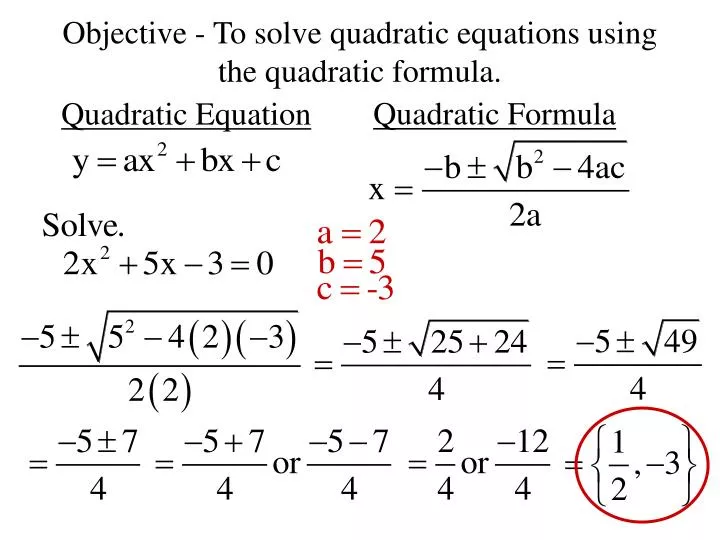


No real root if the discriminant b 2 – 4 ac is a negative number.One real root if the discriminant b 2 – 4 ac is equal to 0.Two different real roots if the discriminant b 2 – 4 ac is a positive number.A quadratic equation with real numbers as coefficients can have the following: The discriminant is the value under the radical sign, b 2 – 4 ac.

These three possibilities are distinguished by a part of the formula called the discriminant. When using the quadratic formula, you should be aware of three possibilities. Where a is the numeral that goes in front of x 2, b is the numeral that goes in front of x, and c is the numeral with no variable next to it (a.k.a., “the constant”). A second method of solving quadratic equations involves the use of the following formula:Ī, b, and c are taken from the quadratic equation written in its general form of This is generally true when the roots, or answers, are not rational numbers. Many quadratic equations cannot be solved by factoring. To check, 2 x 2 + 2 x – 1 = x 2 + 6 x – 5 X 2 – 6 x = 16 becomes x 2 – 6 x – 16 = 0īoth values, 8 and –2, are solutions to the original equation.Ī quadratic with a term missing is called an incomplete quadratic (as long as the ax 2 term isn't missing).įirst, simplify by putting all terms on one side and combining like terms. Check by inserting your answer in the original equation.Put all terms on one side of the equal sign, leaving zero on the other side.To solve a quadratic equation by factoring, There are three basic methods for solving quadratic equations: factoring, using the quadratic formula, and completing the square. Quiz: Linear Inequalities and Half-PlanesĪ quadratic equation is an equation that could be written as.Solving Equations Containing Absolute Value.Inequalities Graphing and Absolute Value.Quiz: Operations with Algebraic Fractions.Quiz: Solving Systems of Equations (Simultaneous Equations).Solving Systems of Equations (Simultaneous Equations).Quiz: Variables and Algebraic Expressions.Quiz: Simplifying Fractions and Complex Fractions.Simplifying Fractions and Complex Fractions.Quiz: Signed Numbers (Positive Numbers and Negative Numbers).Signed Numbers (Positive Numbers and Negative Numbers).Quiz: Multiplying and Dividing Using Zero.Quiz: Properties of Basic Mathematical Operations.Properties of Basic Mathematical Operations.Each quadratic function will have two, one, or no x-intercepts. These points are also known as zeroes, roots, solutions, and solution sets. The x-intercepts are the points at which a parabola intersects the x-axis.The line of symmetry is always a vertical line of the form x = n, where n is a real number, and its axis of symmetry is the vertical line x =0. An axis of symmetry (also known as a line of symmetry) will divide the parabola into mirror images.If the vertex is a maximum, the range is all real numbers less than or equal to the y-value. If the vertex is a minimum, the range is all real numbers greater than or equal to the y-value.The domain of a quadratic function consists entirely of real numbers.A parabola that opens upward contains a vertex that is a minimum point a parabola that opens downward contains a vertex that is a maximum point.The parabola will open upward or downward.The graph this creates is a parabola - a u-shaped figure.y = ax2 + bx + c, where a is not equal to 0.


 0 kommentar(er)
0 kommentar(er)
